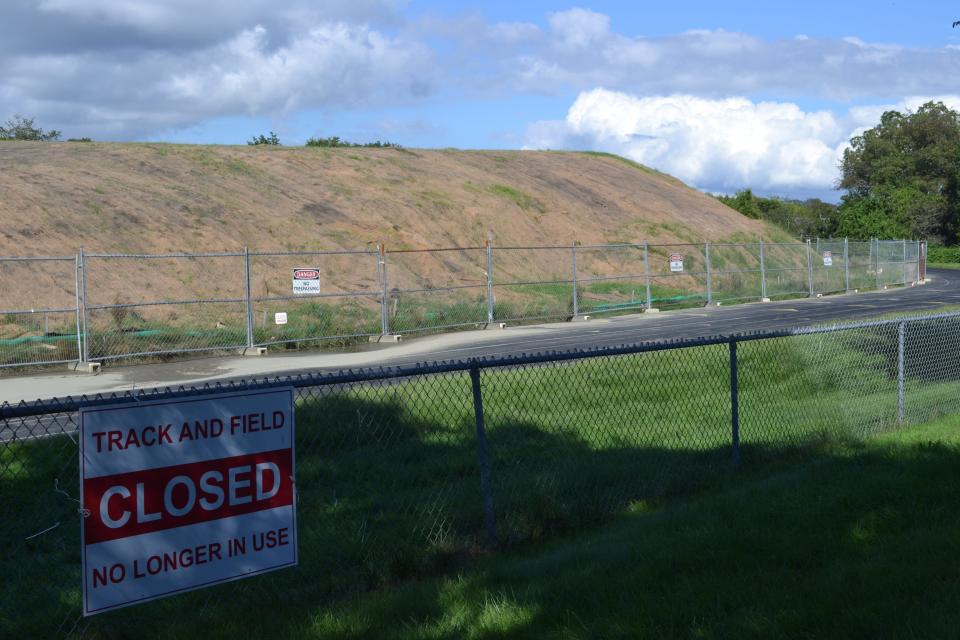Independent test of Rogers High School soil competed. Here's what was found.
The results from an independent test of the soil stockpile at Rogers High School the Newport City Council ordered show “similar” results to those found by the school’s environmental contractor, Pare Corporation, according to the recently released report.
As the construction team building the new Rogers High School began excavating the soil on site and stockpiling it nearby, residents and city officials began raising concerns over the potential contamination in the stockpiled soil and its possible impacts on the health of the students at the old school, as well as the neighbors of the school. The site, which is on the same land as the current high school, was a World War II-era naval battery factory, a quarry and a municipal dump before the current high school’s construction.
Although the site did undergo three rounds of soil testing through the project’s environmental consultants, Pare Corporation, the City Council ordered an additional, independent test be conducted on the soil stockpile in August 2023 to better address the anxieties of residents in the neighborhood. The city contracted Vanasse Hangen Brustlin, Inc. (VHB) for $39,350 to test the soil plus an additional $15,000 to uncover and recover the pile with coconut matting that covered the pile.

The initial results
The first test by Pare Corporation was conducted in early 2022 as a part of the second phase of the Rhode Island Department of Education’s Necessity of School Construction program. The report revealed most of the sampled soil had levels of Total Petroleum Hydrocarbons (TPH), lead, Polycyclic Aromatic Hydrocarbons (PAHs) and arsenic above the Rhode Island Department of Environmental Management’s recommended levels for residential areas, specifically called the Method 1 Residential Direct Exposure Criteria.
Pare sampled the site two more times, once in March 2023 where 18 samples of the stockpile were tested and another time in July 2023, where 20 to 25 samples were taken from the stockpile. Both of these tests revealed similar results to the initial one taken in 2022. Much of the information on this process has been documented and made available on RIDEM’s website.
Despite this, RIDEM permitted the construction team to temporarily stockpile excavated soil on the current track and field and soil that could be demonstrated as being below the RDEC would be reused as fill for the construction project.
The independent results: how do they differ?
VHB took 24 soil samples from between seven feet to as deep as 18 feet within the pile, much deeper than the most tests Pare underwent in March 2023. For the most part, the report states that the results of the tests are “relatively similar” and the stockpile had been “adequately sampled,” by Pare. The report does note that the levels of certain contaminants were higher on average in VHB’s data, such as the PAH concentrations. Unlike Pare’s analysis, which indicated that none of the average PAH concentrations exceeded an applicable RIDEM criteria and only seven of the maximum PAH concentrations were higher than RIDEM’s residential standard, VHB reported three average PAH concentrations and 12 maximum PAH concentrations were higher than their respective criteria.
Additionally, VHB identified two compounds, Naphthalene, a PAH, and 1,1-Biphenyl, a semi-volatile organic compound, as having a maximum concentration exceeding RIDEM criteria, neither of which were reported in the Pare data.
What's next?
VHB’s report stated that both its data and Pare’s data reflected “lead, arsenic and various PAH compounds at concentrations requiring remedial action,” and suggested typical remedial actions such as off-site disposal and/or capping and regrading the soil with a RIDEM-approved barrier, such as pavement, geotextile fabric or clean imported soil. It also recommended implementing an Environmental Land Usage Restriction to “eliminate exposure and potential adverse impacts to human health and the environment,” as well as implementing periodic inspections and erosion controls for the stockpile in the meantime.
School building projects: Opening of new Rogers High School pushed back to 2025. An in-depth look at how we got here
In addition to the new test results, a new memorandum from interim City Manager Laura Sitrin suggests the school building’s consultants have recently determined the soil in the stockpile is too silty to be used to backfill the project. Sitrin’s memo recommends informing the School Department they cannot add any more excavated soil to the pile or anywhere on site and that the city hire legal and environmental consultants to get a further understanding of what can be done about the capped landfill underneath the track and field as well as what can be done about the current soil stockpile.
The memo and report will be considered by the Newport City Council at its regular meeting on Wednesday, Jan. 24.
This article originally appeared on Newport Daily News: Rogers High School dirt pile independent test completed

